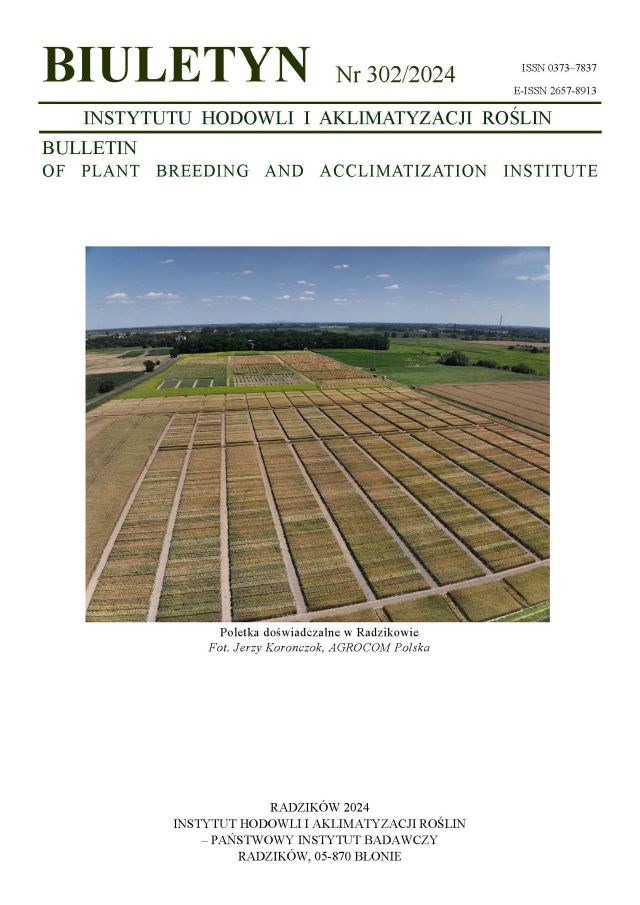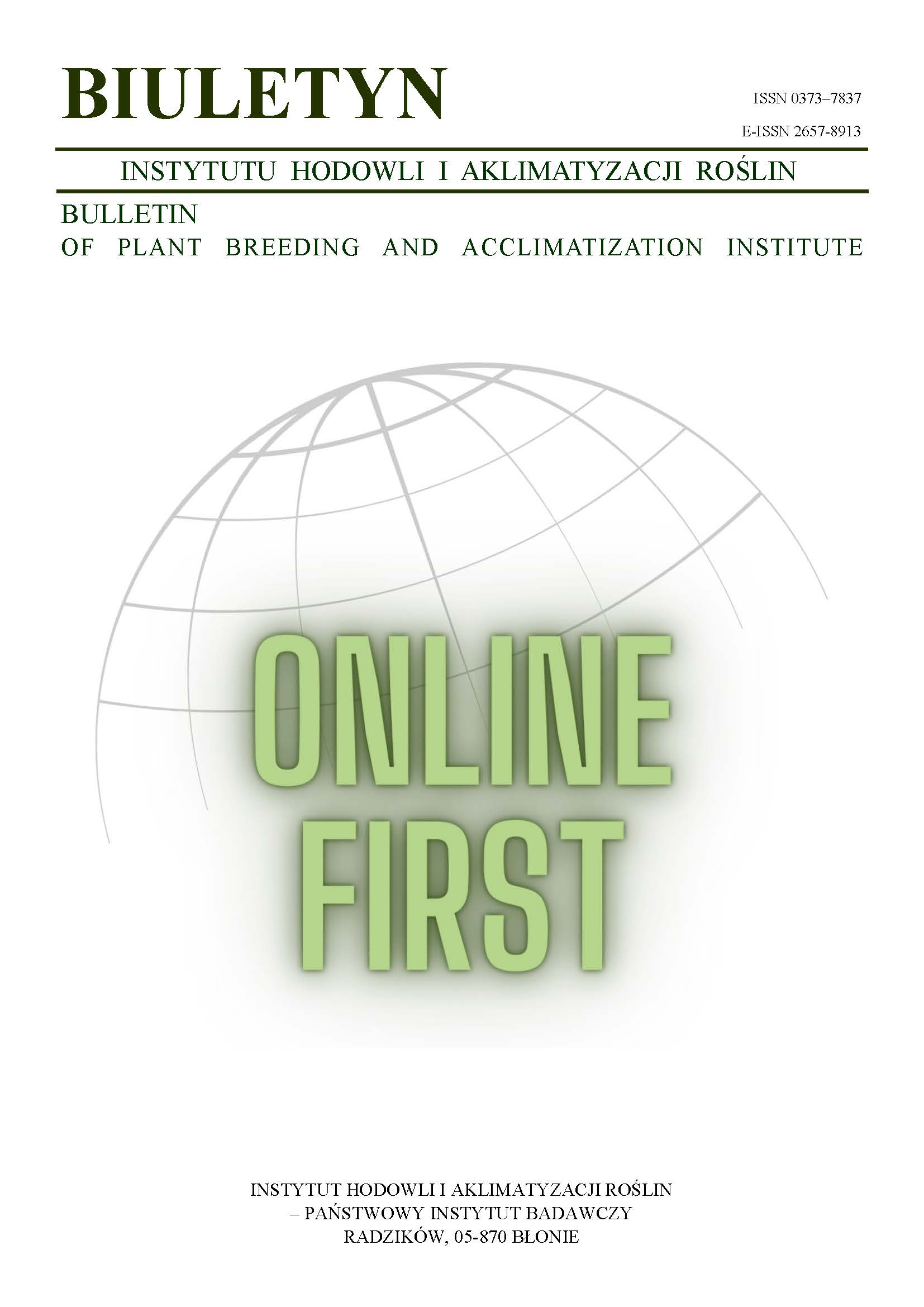Grass endophytes — importance, incidence and methods for detection
Maria Prończuk
m.pronczuk@ihar.edu.plSamodzielna Pracownia Traw i Roślin Motylkowatych, Instytut Hodowli i Aklimatyzacji Roślin, Radzików (Poland)
Abstract
Species of Neotyphodium fungi are presented, such as N. lolii, N. coenophialum and N. uncinatum, living in systemic coexistence with Lolium perenne, Festuca pratensis and Festuca arundinacea. Their taxonomy, biology and the produced alkaloids are described. Beneficial and harmful effects of the grass and endophytes coexistence are shown. The results of research on the endophyte incidence and distribution in the world, Europe and Poland are presented. The necessity of intensification of research on the Neotyphodium fungi in Poland has been emphasized. Methods for endophytes detection in seed and plant are presented.
Keywords:
Festuca arundinacea, Festuca pratensis, N. coenophialum, Neotyphodium lolii, Neotyphodium uncinatum, Lolium perenne, taxonomy, alkaloids, biologyReferences
Aust H. J. 2000. Comparison of the colonization of monocotyledonous and dicotyledonouus plants by endophytic fungi. Proc. of the 4th International Neotyphodium/Grass Interactions Symposium, Soest, Germany: 9 — 16.
Google Scholar
Bacon C. W., White J. F. Jr. 1994. Stains, media and procedure for analyzing endophytes. In: Biotechnology of endophytic fungi of grasses. Bacon Ch W, White J.F.Jr. (eds).CRC Pres, Boca Raton: 47 — 56.
DOI: https://doi.org/10.1201/9781351070324-4
Google Scholar
Barker G. M., Pottinger R. P., Adison P. J., Prestidge R. A. 1984. Effect of Lolium endophyte fungus infections on behaviour of adult Argentine stem weevil. New Zealand Journal Agric. Res. 27: 271 — 277.
DOI: https://doi.org/10.1080/00288233.1984.10430429
Google Scholar
Barker D. J., Davies E., Lane G. A., Latch G. C. M., Nott H. M., Tapper B. A. 1993. Effect of water deficit on alkaloid concentrations in perennial ryegrass endophyte associations. Proc of 2nd International Symposium on Acremonium/grass interactions. Palmerston North, New Zealand: 67 — 71.
Google Scholar
Bayle B., Huyghe C., Gensollen V., Bourgoin B. 2003. System of variety testing and registration in France for forage and turf. Book of Abstracts of the 25th EUCARPIA Fodder Crops and Amenity Grasses Section Meeting. Brno, Czech Republik: 119.
Google Scholar
Belesky D. P., Robbins J. D., Stuedemann J. A., Wilkinson S. R., Devine O. J. 1987. Fungal endophyte infection-loline derivative alkaloid concentration of grazed tall fescue. Agron. J. 79: 217 — 220.
DOI: https://doi.org/10.2134/agronj1987.00021962007900020009x
Google Scholar
Bony S., Delatour P. 2000. Relevance and impact of grass endophyte toxins in Europe. Proc. of 4th International Neotyphodium/grass Interactions Symposium. Soest, Germany: 207 — 218.
Google Scholar
Bouter W., van Klooster G. 1996. Practical endophyte-work at the Barenbrug Grass Breeding Department. IOBC wprs Bulletin 19 (7): 59 — 62.
Google Scholar
Cappelli C., Buonaurio R. 2000. Occurrence of endophytic fungi in grass seeds and plants in Italy. Proc. of the 4th International Neotyphodium/Grass Interactions Symposium, Soest, Germany: 131 — 137.
Google Scholar
Dapprich P., Paul. V. H., Krohn K. 1994. A novel and rapid staining method for the detection of vital endophytes in seeds and leaf sheaths of Lolium perenne. IOBC wprs Bulletin 17/1: 139 — 146.
Google Scholar
Doss R. P., Welty R. E. 1995. A polymerase chain reaction-based procedure for detection of Acremonium coenophialum in tall fescue. Phytopathol. 85: 913 — 917.
DOI: https://doi.org/10.1094/Phyto-85-913
Google Scholar
Fletcher L. R., Harvey I. C. 1981. An association of a Lolium endophyte with ryegrass staggers. New Zealand Vet. J. 29: 185 — 186.
DOI: https://doi.org/10.1080/00480169.1981.34839
Google Scholar
Fletcher L. R., Easton H. S. 2000. Using endophytes for pasture improvement in New Zealand. Proc. of the 4th International Neotyphodium/Grass Interactions Symposium, Soest, Germany: 149 — 162.
Google Scholar
Gartwhaite I., Miles C. O., Towers N. R. 1994. An immunological approach to the study of the ryegrass staggers syndrome. IOBC wprs Bulletin 17 (1): 175 — 180.
Google Scholar
Flieger M., Osovska J., Halada P., Pazoutova S., Cagas B., Shelby R. A. 2000. Chanoclavine I and lyserol, clavine alcaloides produced by Neotyphodium spp. Proc. of the 4th International Neotyphodium/Grass Interactions Symposium, Soest, Germany: 515 — 519.
Google Scholar
Funk C. R., Belanger F. C., Murphy J. A. 1994. Role of endophytes in grasses used for turf and soil conservation. In: Biotechnology of endophytic fungi of grasses. Bacon Ch. W, White J. F. Jr. (eds.).CRC Press., Boca Raton: 201 — 209.
DOI: https://doi.org/10.1201/9781351070324-14
Google Scholar
Gams W., Petroni O., Schmidt D. 1990. Acremonium unicatum, a new endophyte in Festuca pratensis. Mycotaxon 37: 67 — 71.
Google Scholar
Glenn A. E., Bacon C. W., Price R., Hanlin R. T. 1996. Molecular phylogeny of Acremonium and its taxonomic implications. Mycologia 88: 369 — 383.
DOI: https://doi.org/10.1080/00275514.1996.12026664
Google Scholar
Guillaumin J. J., Frain M., Pichon N., Ravel C. 2000. Survey of the fungal endophytes in wild grass species in the Auvergne region (central France). Proc. of the 4th International Neotyphodium/Grass Interactions Symposium, Soest, Germany.: 85 — 92.
Google Scholar
Hahn H., Huth W., Schöberlein W. 2000 Tissue print immunoassay — a rapid and sensitive method also for detection of Neotyphodium endophytes. Proc. of the 4th International Neotyphodium/Grass Interactions Symposium, Soest, Germany: 139 — 143.
Google Scholar
Hinton D. M., Bacon C. W. 1985. The distribution and ultrastructure of the endophyte of toxic tall fescue. Can. J. Bot. 63: 36 — 42.
DOI: https://doi.org/10.1139/b85-006
Google Scholar
Hoveland C. S. 2000. Endophytes — research and impact. Proc. of the 4th International Neotyphodium/grass Interactions Symposium. Soest, Germany: 123 — 130.
Google Scholar
Hill N. S., Hiatt E. E., De Battista J. R., Costa M. C., Griffiths C. H., Klap J., Thorogood D., Reeves J. H. 2002. Seed testing for endophytes by microscopic and immunoblot procedures. Seed Science and Technology 30: 347 — 355.
Google Scholar
Johnson M. C., Pirone I. P., Siegel M. R., Varney, D. R. 1982. Detection of Epichloe typhina in tall fescue by means of enzyme-linked immunosorbent assay. Phytopathology 72: 647 — 650.
DOI: https://doi.org/10.1094/Phyto-72-647
Google Scholar
Justus M., Witte L., Hartman T. 1997. Levels and tissue distribution of loline alkaloids in endophyte-infected Festuca pratensis. Phytochemistry 44/1: 51 — 57.
DOI: https://doi.org/10.1016/S0031-9422(96)00535-3
Google Scholar
Koga H., Tsukiboshi T., Uematsu T. 1993. Incidence of the endophyte fungus, Acremonium uncinatum, in Meadow Fescue (Festuca pratensis) ecotypes in Hokkaido. Bull. Natl. Grassl. Res. Inst. 49: 35 — 41.
Google Scholar
Latch G. C. M., Christensen M. J. 1982. Ryegrass endophyte, incidence and control. New Zealand Journal of Agricultural Research. 25: 443 — 448.
DOI: https://doi.org/10.1080/00288233.1982.10417910
Google Scholar
Latch G. C. M., Christensen M. J., Samuels G. J. 1984. Five endophytes of Lolium and Festuca in New Zealand. Mycotaxon 20: 535 — 550.
Google Scholar
Leuchtmann A., Schardll C. 1998. Mating compatibility and phylogenetic relationship among two species of Epichloë and other congeneric European species. Mycological Research 102: 1169 — 1182.
DOI: https://doi.org/10.1017/S0953756298006236
Google Scholar
Lewis. G. C. 2000. Neotyphodium endophytes: incidence, diversity, and host in Europe. Proc. of the 4th International Neotyphodium/grass Interactions, Symposium. Soest, Germany: 123 — 130.
Google Scholar
Leyronas C., Raynal G. 2001. Presence of Neotyphodium-like endophytes in European grasses. Ann. Appl. Biol. 139: 119 — 129.
DOI: https://doi.org/10.1111/j.1744-7348.2001.tb00136.x
Google Scholar
Lewis G. 2000. Neotyphodium endophytes: incidence, diversity, and hosts in Europe. Proc. of the 4th International Neotyphodium/grass Interactions Symposium. Soest, Germany: 123 — 130.
Google Scholar
Liu D., Van Heeswijck R. Latch G., Leonforte T., Panaccio M., Langford C., Cunninham P., Reed K. 1995. Rapid identification of Acremonium coenophialum endophytes through arbitrarily primed PCR. FEMS Microbiology Letter 133: 95 — 98.
DOI: https://doi.org/10.1111/j.1574-6968.1995.tb07867.x
Google Scholar
Malinowski D. P., Belesky D. P. 2000. Adaptations of endophyte-infected cool-season grasses to environmental stresses: mechanisms of drought and mineral stress tolerance. Crop Sci. 40: 923 — 940.
DOI: https://doi.org/10.2135/cropsci2000.404923x
Google Scholar
Morgan-Jones G., Gams W. 1982. Notes on Hyphomycetes. XLI. An endophyte of Festuca arundinacea and the anamorph of Epichloë typhina, new taxa in one of two new sections of Acremonium. Mycotaxon 15: 311 — 318.
Google Scholar
Mühle E., Frauenstein L., Schumann K., Wetzel T. 1975. Choroby i szkodniki traw pastewnych. PWRiL, Warszawa: 1 — 412.
Google Scholar
Oliviera J. A., Rottinghaus G. E., Prego C. 2000. Endophytic fungi and alkaloid production in grass seeds in Northern Spain. Proc. of 4th International Neotyphodium/grass Interactions Symposium. Soest, Germany: 413 — 417.
Google Scholar
Pańka D., Łukanowski A. 2000. Occurrence of Acremonium lolii in perennial ryegrass (Lolium perenne L.) cultivated in the Kujawy and Pomerania region of Poland. Proc. of 4th International Neotyphodium/grass Interactions Symposium. Soest, Germany: 419 — 421.
Google Scholar
Pańka D., Sadowski Cz. 2002. Occurrence of fungal endophytes in perennial ryegrass (Lolium perenne L.) cultivars in Poland. In: Multi-functional grasslands quality forages, animal products and landscapes. Durand J. L. et al., (eds.). Grassland science in Europe. Vol. 7: 540 — 541.
Google Scholar
Pańka D. Podkówka L., Lamparski R. 2004. Preliminary observations on the resistance of meadow festucue (Festuca pratensis Huds.) infected by Neotyphodium uncinatum to diseases and pests and native value. In: Proc. of 5th International Symposium on Neotyphodium/ Grass Interaction. Kallenbach R. et al. (eds.).Fayetteville, AR USA, May 23–26, 2004, 401: 88 — 90.
Google Scholar
Paul V. H., Dapprich D., Krohn K. 2000. Preface. Proc. of the 4th International Neotyphodium/Grass Interactions Symposium, Soest, Germany: 1.
Google Scholar
Paul V. H., Ostbohmke H., Feuerstein U. 2000 a. Studies on the dynamics of colonization of the endophytic fungus Neotyphodium lolii (Latch, Christensen& Samuels) Glenn, Bacon & Hanlin comb. Nov) (syn. Acremonium lolii (Latch, Christensen & Samuels) in perennial ryegrass (Lolium perenne L.) in an European grass breeding process. Proc. of the 4th International Neotyphodium/Grass Interactions Symposium, Soest, Germany: 71 — 77.
Google Scholar
Petroni O. 1986. Taxonomy of endophytic fungi of aerial plant tissues. In: Microbiology of Phyllosphere. Cambridge University Press, Cambridge: 175 — 187.
Google Scholar
Pfannmöller M., Eggestein S., Schöberlein W. 1994. Endophytes in European varieties of Festuca species. IOBC wprs Bulletin 17/1: 101 — 109.
Google Scholar
Porter J. K. 1995. Analysis of endophyte toxins: fescue and other grasses toxic to livestock. J. Anim. Sci 73: 871 — 880.
DOI: https://doi.org/10.2527/1995.733871x
Google Scholar
Raynal G. 1991. Liberation des ascospores d’Epichloe typina agent la quenouille du dactyle. Consequence pour l’epidemiologie et la lutte. Fourages 127: 345 — 358.
Google Scholar
Reed K. M., Walsh J. R., McFarlanne N. M., Cross P. A. 2000 Australian perennial ryegrass pasture, endophyte frequency and associated alkaloid concentrations. Proc. of the 4th International Neotyphodium/Grass Interactions Symposium, Soest, Germany: 31 — 39.
Google Scholar
Reinholz J., Dapprich P.D. Holzmann-Wirth A., Paul V. H. 2000. A two year field study to monitor the effect of nitrogen fertilization on dry matter yield and lolitrem B content Neotyphodium lolii infected Lolium perenne L. Proc. of the 4th International Neotyphodium/Grass Interactions Symposium, Soest, Germany: 51 — 64.
Google Scholar
Rolston M. P., Rowarth J. S. 1995. Aspects of endophyte in ryegrass (Lolium perenne) seed production. Proc of Third International Herbage Seed Conference, Halle, Germany: 433 — 437.
Google Scholar
Saha D. C., Jackson M. A., Jonson-Cicalese J. M. 1988. A rapid staining method for detection of endophytic fungi in turf and forage grasses. Phytopathology 78: 237 — 239.
DOI: https://doi.org/10.1094/Phyto-78-237
Google Scholar
Siegel M. R., Varney D. R., Johnson M. C., Nesmith.W. C., Buckner R. C., Bush L. P., Burrus P. B., Hardison J. R. 1984. A fungal endophyte of tall fescue: evaluation of control methods. Phytopathology 74/8: 937 — 941.
DOI: https://doi.org/10.1094/Phyto-74-937
Google Scholar
Siegel M. R., Latch G. C. M., Johnes M. C. 1985. Acremonium fungal endophytes of Tall Fescue and Perennial ryegrass: significance and control. Plant Dis. 69/2: 179 — 183.
Google Scholar
Vazquez de Aldana B. R., Zabalgogeazcoa I., Garcia-Ciudad A., Gracia-Criado B. 2000. Detection of ergovaline in endophyte infected Holcus lanatus from natural grassland in western Spain. Proc. of the 4th International Neotyphodium/Grass Interactions Symposium, Soest, Germany: 477 — 481.
Google Scholar
White J. F. Jr., Cole G. T. 1985. Endophyte-host associations in forage grasses. I. Distributions of fungal endophytes in some species of Lolium and Festuca. Mycologia 77: 323 — 327.
DOI: https://doi.org/10.1080/00275514.1985.12025104
Google Scholar
White J. F. Jr., Cole G. T. 1986. Endophyte-host associations in forage grasses. IV. The endophyte of Festuca versusa. Mycologia 78: 102 — 107.
DOI: https://doi.org/10.1080/00275514.1986.12025211
Google Scholar
White J. F. Jr. 1987. Widespread distribution of endophytes in the Poaceae. Plant Disease 71: 340 — 342.
DOI: https://doi.org/10.1094/PD-71-0340
Google Scholar
White J. F. Jr., Mongan-Jones G. 1987. Endophyte — host associations in forage grasses. IX. Concerning Acremonium typhinum, the anamorph of Epichloë typhina: Mycotaxon 29: 489 — 500.
Google Scholar
Wäli P., Saikkonen K., Helander M., Lehtimäki S., Lehtonen P. 2000. Seed transmitted endophytic fungi in wild grass population in Finland. Proc. of 4th International Neotyphodium/grass Interactions Symposium. Soest, Germany: 93 — 96.
Google Scholar
Welty R. E., Rennie W. J. 1985. ISTA Handbook on seed health testing. Working sheet No 55: Grasses, Endophyte. International Seed Testing Association, Zurich, Switzerland: 1 — 4.
Google Scholar
Welty R. E., Azevedo M. D., Cook K. L. 1986. Detecting viable Acremonium endophytes in leaf sheaths and meristems of tall fescue and perennial ryegrass. Plant Dis. 70: 431 — 435.
DOI: https://doi.org/10.1094/PD-70-431
Google Scholar
Welty R. E., Azevado M. D. Cooper T. M. 1987. Influence of moisture content, temperature, and length of storage on seed germination and survival of endophytic fungi in seeds of tall fescue and perennial ryegrass. Phytopathology 77: 893 — 900.
DOI: https://doi.org/10.1094/Phyto-77-893
Google Scholar
Welty R. E., Milbrath G. M., Faulkenberry D., Meek L., Hall K. 1986. Endophyte detection in tall fescue seed by staining and ELISA. Seed Sci. Technol. 14: 105 — 116.
Google Scholar
West C. P., Gwinn K. D. 1993. Role of Acremonium in drought, pest, and disease tolerance of grasses. Proc of 2nd International Symposium on Acremonium/grass interactions. Palmerston North, New Zealand: 131 — 140.
Google Scholar
Woodburn O. J., Walsh J. R., Foot J. Z., Hazlewood P. G. 1993. Seasonal ergovaline concentrations in perennial ryegrass cultivars of differing endophyte status. Proc of 2nd International Symposium on Acremonium/grass interactions. Palmerston North, New Zealand: 100 — 102.
Google Scholar
Authors
Maria Prończukm.pronczuk@ihar.edu.pl
Samodzielna Pracownia Traw i Roślin Motylkowatych, Instytut Hodowli i Aklimatyzacji Roślin, Radzików Poland
Statistics
Abstract views: 82PDF downloads: 35
License
Copyright (c) 2005 Maria Prończuk

This work is licensed under a Creative Commons Attribution-ShareAlike 4.0 International License.
Upon submitting the article, the Authors grant the Publisher a non-exclusive and free license to use the article for an indefinite period of time throughout the world in the following fields of use:
- Production and reproduction of copies of the article using a specific technique, including printing and digital technology.
- Placing on the market, lending or renting the original or copies of the article.
- Public performance, exhibition, display, reproduction, broadcasting and re-broadcasting, as well as making the article publicly available in such a way that everyone can access it at a place and time of their choice.
- Including the article in a collective work.
- Uploading an article in electronic form to electronic platforms or otherwise introducing an article in electronic form to the Internet or other network.
- Dissemination of the article in electronic form on the Internet or other network, in collective work as well as independently.
- Making the article available in an electronic version in such a way that everyone can access it at a place and time of their choice, in particular via the Internet.
Authors by sending a request for publication:
- They consent to the publication of the article in the journal,
- They agree to give the publication a DOI (Digital Object Identifier),
- They undertake to comply with the publishing house's code of ethics in accordance with the guidelines of the Committee on Publication Ethics (COPE), (http://ihar.edu.pl/biblioteka_i_wydawnictwa.php),
- They consent to the articles being made available in electronic form under the CC BY-SA 4.0 license, in open access,
- They agree to send article metadata to commercial and non-commercial journal indexing databases.
Most read articles by the same author(s)
- Barbara Wiewióra, Maria Prończuk, Anna Ostrowska, The infestation of seed of grasses by endophytes in successive years of harvesting , Bulletin of Plant Breeding and Acclimatization Institute: No. 242 (2006): Special issue
- Maria Prończuk, Jan Bojanowski, Roman Warzecha, Zbigniew Laudański, Studies on resistance of maize to fusarium stalk rot. Part I. Evaluation of susceptibility of hybrid cultivars under natural infection , Bulletin of Plant Breeding and Acclimatization Institute: No. 245 (2007): Regular issue
- Maria Prończuk, Sławomir Prończuk, Search of Kentucky bluegrass (Poa pratensis) cultivars and ecotypes for low maintenance turf , Bulletin of Plant Breeding and Acclimatization Institute: No. 248 (2008): Regular issue
- Sławomir Prończuk, Maria Prończuk, Evaluation of the response of perennial ryegrass (Lolium perenne L.) cultivars to temporary shading in turf maintenance , Bulletin of Plant Breeding and Acclimatization Institute: No. 248 (2008): Regular issue
- Barbara Wiewióra, Maria Prończuk, Comparison of aniline blue staining and immunoblotting methods for detecting endophytic fungi in grass seeds , Bulletin of Plant Breeding and Acclimatization Institute: No. 242 (2006): Special issue
- Maria Prończuk, Maciej Prończuk, Zbigniew Laudański, Sławomir Prończuk, Comparison of species and cultivars of Festuca spp. in many-years of turf maintenance , Bulletin of Plant Breeding and Acclimatization Institute: No. 225 (2003): Special issue
- Zbigniew Laudański, Maciej Prończuk, ], Proposition of turf characters synthesis for assessment of Festuca spp. cultivars value , Bulletin of Plant Breeding and Acclimatization Institute: No. 233 (2004): Regular issue
- Sławomir Prończuk, Maria Prończuk, Variability of turf characters of Poa pratensis L. cultivars under medium intensive turf maintenance , Bulletin of Plant Breeding and Acclimatization Institute: No. 225 (2003): Special issue
- Maria Prończuk, Sławomir Prończuk, Yellow rust — new infection threat for Kentucky bluegrass grown for turf and seed in Poland , Bulletin of Plant Breeding and Acclimatization Institute: No. 225 (2003): Special issue
- Maria Prończuk, Fairy rings and basidiocarps of fungi in lawns — literature review) , Bulletin of Plant Breeding and Acclimatization Institute: No. 237/238 (2005): Regular issue














